What happened to Ethereum in 2024?
We can divide it into 3 themes:
Applications: The ecosystem of products and services built on Ethereum.
Infrastructure: The technology that makes all of this possible.
Community: You, me, and everyone who uses Ethereum or contributes to it.
Applications
Ethereum is changing the world because it solves problems for people. Developers around the world are using Ethereum to build what users want. But Ethereum is not just one thing - it is a platform that serves a multitude of use cases. One of those use cases is stablecoins. Stablecoins give everyone the freedom to transact: to send money home to family or to save. I believe they are still underappreciated - stablecoins fundamentally enhance the freedom of people globally.
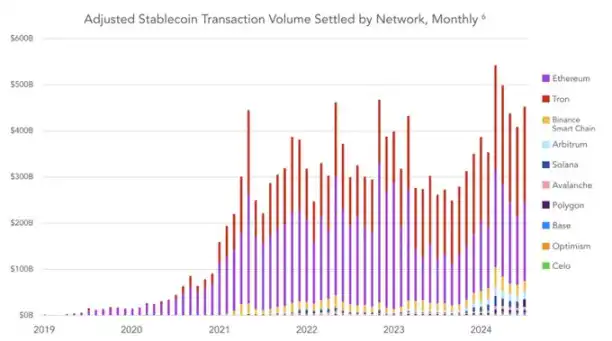
Stablecoins exist on many chains, but the Ethereum ecosystem plays a unique role as the venue for the circulation of most existing stablecoins. And the number of stablecoins in the Ethereum ecosystem now rivals the major payment processing networks, including Mastercard and Visa.

Behind all of these statistics are stories and use cases. For example, Bitso uses stablecoins on Ethereum to provide faster, cheaper remittances in Latin America; Pintu leverages stablecoins to offer better savings products for users in Indonesia.
Ethereum is also the birthplace of DeFi. These applications leverage Ethereum's unique properties to build financial products that cannot be discriminated against or shut down, and that give people better control over their own money. DeFi was invented on Ethereum, and the Ethereum ecosystem remains its home. Today, around 60% of the value in DeFi applications is stored on Ethereum or Ethereum L2s.

Behind these massive numbers are the real benefits to ordinary people around the world. In Mexico, EthicHub uses DeFi to connect small business owners like coffee producers with lenders who provide the capital they need to grow their businesses.
And there is "more" DeFi on Ethereum that I can't cover in this talk. Thank you to all the teams, companies, DAOs, and independent developers building this ecosystem. Stablecoins and DeFi are Ethereum's earliest use cases, and they continue to mature, grow, and scale. But Ethereum is also a blockchain ecosystem that is producing new things.
New things like social networks like Farcaster, Lens, and Zora that use Ethereum to give users control over their own identity and even share in the growth of the platforms. And new games like EVE Frontier, a new MMO where the physical properties of the game world are built as smart contracts, allowing players to construct autonomous systems on top of it.
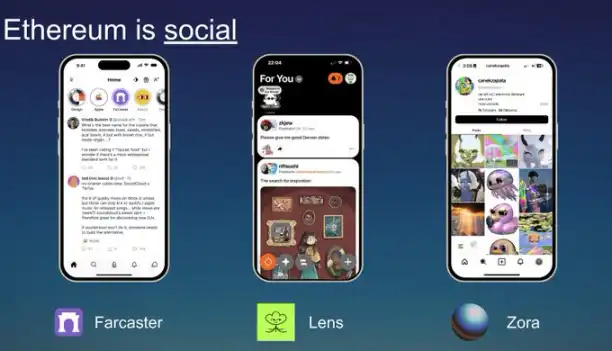
Decentralized identity systems like ENS and AnonAadhaar give users options that centralized or traditional IDs don't. Real-world infrastructure like Glow using the Ethereum ecosystem to incentivize hundreds of solar power plants.

Breakthrough successes in prediction markets like Polymarket, and the Polygon team showing the world the possibilities of building open, on-chain systems. I'm very excited about Polygon PoS's upcoming transition to become an Ethereum validator. What I love about the Ethereum ecosystem is that Ethereum is where creativity meets production. Prediction markets were an idea, formalized and debated in academic work for decades. It is on Ethereum that early experiments have led to breakthrough successes.

Quadratic funding is another idea that was formally developed in academic work over the years. Then multiple teams in the Ethereum ecosystem adopted these ideas and built products that serve users around the world today.

Ethereum is a developer's platform. By 2024, Ethereum will be the "best" platform for developers in the crypto ecosystem. This is especially true when you look at chain ecosystem data on what project founders are building or "interested" in building:

A key reason for this is the extremely deep and comprehensive developer tooling ecosystem on Ethereum, which builds and maintains everything developers need to launch, deliver, and build applications that can safely scale to millions of users globally.
When we look across, what do we see in Ethereum's application layer? Ethereum has the oldest, most mature use cases: money, stablecoins, DeFi; Ethereum is also where new things are being born, and Ethereum has the best developer ecosystem. Looking across our ecosystem, seeing the confidence and excitement in every domain, I can fairly say that Ethereum's ambition is to lead in every dimension.
Infrastructure
Behind every application is a technology layer, which includes the Ethereum L1 and L2 networks. Over the past few years, the Ethereum ecosystem has made massive investments in improving this infrastructure. Ethereum is the only blockchain with enough real demand to push it to the limits, and that requires a difficult but necessary path to true scalability without compromise.
Most of the investment has been around L2s or Rollups. I won't go into the details here, but I want to provide a very simple mental model that anyone can understand. The idea behind L2s is simple: the core is Ethereum L1 - the native smart contract platform and the world's most secure blockchain. But the "surface area" that developers and users can access on L1 is limited, which means it may be relatively expensive. The outer layer is Ethereum L2s, which are networks built "on top" of L1, and they extend its surface area. L2s give developers and users more space to operate at lower cost, but because they can connect to Ethereum in specific ways, they are also very secure.
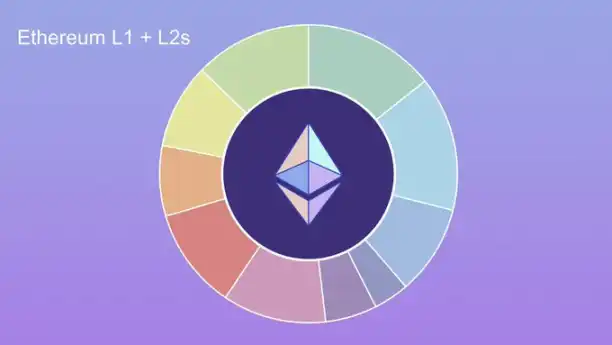
Now, we can't be complacent - there is still a lot of work to be done to complete the L2 roadmap for the ecosystem. But right now, we have some very strong evidence that this strategy is working.
The first piece of evidence is: people are using them! Real-world TPS on Ethereum L2s has seen explosive growth this year, as has TVL in L2s. At the same time, fees have remained low (thanks to EIP 4844) even after key network upgrades earlier this year. On Ethereum L2s, you can send $1, $100, or even $1 million to anyone on Earth for less than a penny.

The second piece of evidence is: developers are starting to leverage the fact that different L2s can be customized for different purposes. This means Ethereum can absorb innovations from any other ecosystem and provide tailored environments for different use cases. The third piece of evidence is: institutions and enterprises are launching L2s and bringing their communities into the Ethereum ecosystem. Ethereum is helping centralized institutions become more decentralized and bringing millions of people onto the chain.

Finally, in the past few years, we've even seen some former L1s decide to transform into L2s within the Ethereum ecosystem, to leverage Ethereum's security and community advantages. We're glad you could make it - welcome to the infinite garden!
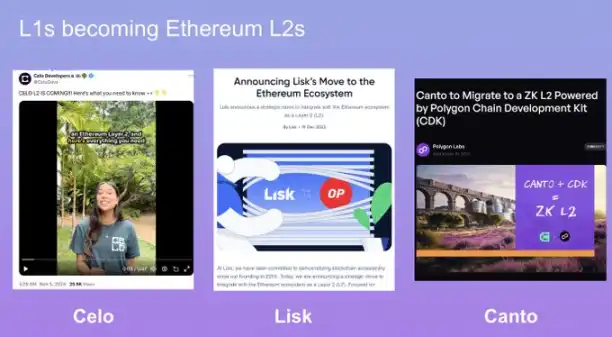
But as I said, we're not done yet. We have two big tasks left for the ecosystem: taking off the training wheels (reaching the final form) and building interoperability
Currently, most L2s are not yet in their "final form", and they will benefit from as much security and decentralization as possible. In fact, the picture I showed earlier looks more like this:
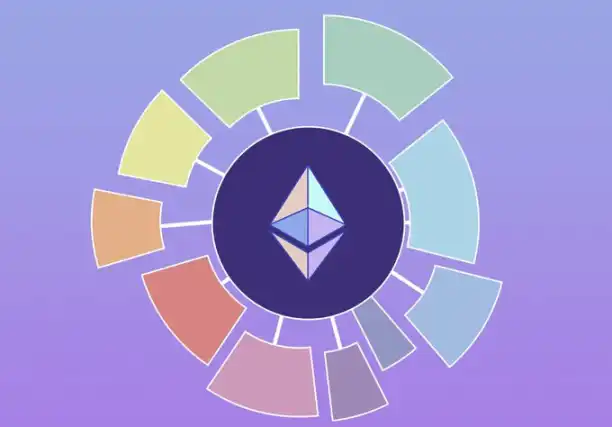
We often refer to these as "stages", and you can learn more about them on L2Beat, with each L2 progressing towards the 2nd stage. There's a lot to be proud of here, as so far two full EVM L2s - Arbitrum and Optimism - have reached the first stage, and surely more will follow soon. Finally, thank you to L2 Beat for tracking, evaluating, and publishing information on each L2's progress towards the 2nd stage. You've helped the Ethereum ecosystem better understand itself, and hold the community accountable for our ambitious goals.
The second task is interoperability and user experience. Using L2s is not as easy as it should be right now. Transferring from one L2 to another, then sending to someone else in the entire ecosystem - this experience is far from what it should be. Instead, it needs to look more like a simple, interoperable network, feeling like an ecosystem because it "is" an ecosystem.
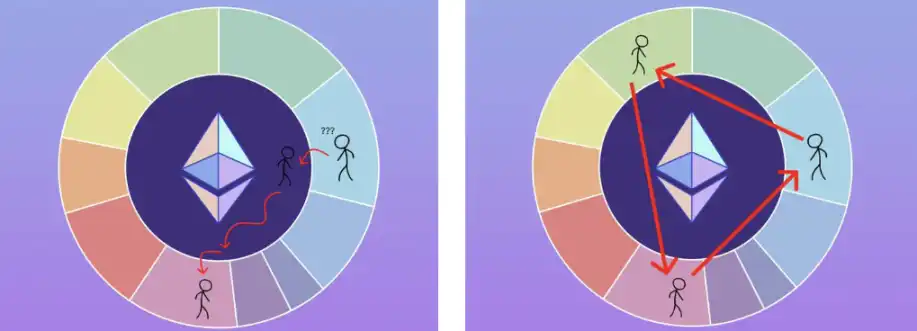
Fortunately, there are hundreds of people in the ecosystem working to make this a reality. Soon we'll have addresses that can be used anywhere, easily sending from one L2 to any other L2, and we'll be able to easily use light clients to verify L2s.
Community
To understand the state of Ethereum today, we must talk about ourselves! The Ethereum community has grown so large and diverse that it's hard to grasp. We can be users of Ethereum applications, ETH holders, application developers, protocol researchers, client developers, L2 developers and L2 commentators, stakers and restakers, Degens and Regens, cypherpunks, activists and radicals, artists, musicians and writers, educators, translators and students, complete newbies and old-timers, and so on.
One incredible feature of the Ethereum community is its true internationalization. There are multiple user and enthusiast communities in every region of the world, as well as developers contributing to applications, L2s, and R&D. Nothing could be better than this. But our community has another quality that is not so obvious. I don't have fancy charts to prove this, but perhaps you've noticed it. Over the past few years, our community has not only grown larger, but also deeper, it has matured.
By 2024, many of us understand that this is not a sprint, but a marathon. We are putting down roots, preparing for the long haul. We are building lasting organizations and companies, we are nurturing the next generation, we have gained the confidence to plan for success.
So - what's the story of Ethereum in 2024? I see the beginning of a virtuous cycle. We are growing, and this growth is testing us, and pushing Ethereum's infrastructure to its limits, and then we build. Better infrastructure can do bigger things, opening up new growth phases. The interplay between adoption, growth, infrastructure, and growth again attracts a community of people who need what Ethereum can provide, who want to plant their own seeds, who hope to build an entire community for the next generation.

We can't be complacent. There are many challenges to solve. But remember: Ethereum has encountered challenges first, because it has gone the furthest.







